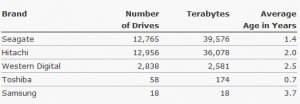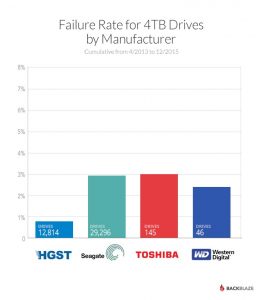The reliability of different hard drive brands has been an endless source of debate among computer enthusiasts and professional I.T. users for years. In the same way that golf enthusiasts extol the virtues of a certain brand of club – some I.T. users have their preferred brand of hard disk. Users will have stories of hard drive brands which have given them stellar performance over the years. Equally, they will have horror stories of hard drive brands which have failed repeatedly or unexpectedly on them.
The problem with most of this anecdotal evidence is that users develop a biased opinion of one hard drive manufacturer versus another brand based on a very small and statistically invalid sample set of hard drives. For example, an I.T. administrator might be dealing with 500 hard drives, all of the same model and all from the same factory batch. If these drives start to show higher-than-expected failure rates, it is likely that he or she might begin to develop a very unfavourable attitude towards their manufacturer. Likewise, personal users are not a great source of information about hard drive reliability either. Most computer users (apart from some of the Drive Rescue crew…), don’t get up in the morning saying “I must run CrystalDiskInfo to check the health of my Seagates this morning”. Users just expect their storage devices to work and that’s the way it should be. Users subject their storage devices to different usage patterns and environmental factors. If a drive does fail taking important data with it; the manufacturer’s name can get etched onto the user’s minds forever. So small sample sizes coupled with different usage patterns and environmental factors can make asking everyday computer users about their perceived reliability of certain brands of hard drive an exercise fraught with bias and statistical error.
Data recovery companies are not a good source of statistically accurate information on hard drive failure rates either.
Data recovery companies are not a good source of statistically accurate information on hard drive failure rates either. After all, they mainly deal with failed drives. The Derstein data recovery laboratory in Moscow (the Russians being world leaders in the field of data recovery) has been collecting drive failure information since the mid-1990’s and some of it’s failure statistics do make for interesting reading. But, as the old saying goes, there are lies, damn lies and statistics. Nowhere in the Derstein survey does it ask users about the usage type of their failed drives, nor does it take into account the environmental factors which the failed drive might have been subjected to. Usage and environmental factors can heavily influence the lifespan of a hard drive. For example, a laptop or portable USB hard drive (which can be subject to more power-up / power-down cycles) owned by a data programmer (higher usage) who lives in a hot country (increased risk of heat-related damage) and travels a lot (increased risk of shock damage) will have a much higher probability of failure than a hard drive sits in an air-conditioned data centre in suburban Dublin.
Data centres have been decidedly cagey about releasing failure rates of their hard drives
This leaves us with data centres as a more statistically sound source of information. Up until now, data centres have been decidedly cagey about releasing failure rates of their hard disks. They would like us all to believe that their disk drives never fail. But there have been some exceptions. In 2007, Google researchers released the results of their study “Failure Trends in Large Disk Drive Population” to the USENIX conference. Their study used a very robust sample of 100,000 S-ATA and P-ATA consumer-grade disk drives ranging in capacity from 80GB to 400GB from their own data centre. They were deployed in rack-mounted servers. The drives were put into service and left powered on for all their service life. The Google survey found that there was a high correlation between the triggering of the SMART early warning system and disk drive failure. It also found that disk temperature and usage levels are less correlated to failure than some people think. But the findings were not exactly ground breaking and failed to mention any relationship between specific hard disk manufacturers and failure rates.
Enter Backblaze, a US online backup company. With a disk population of 27,000 consumer-level drives (a smaller sample than Google but still fairly robust) and most interestingly a willingness to reveal failure rates according to manufacturer. (See figure 1)

As the above chart above suggests Seagate disks have shortest average lifespan of just 1.4 years and Western Digital drives giving the most longevity.

From April 2013 to the end of 2015 Backblaze undertook a similar study primarily with 4TB drives from HGST, Seagate, Toshiba and Western Digital. (Disk population size being a very respectable 42,301). For 4TB disks, which makes up the main size in their data centre, Seagate again had some of the highest failure rates.
In the context of everyday computing, disks are not always continually running in an air-conditioned data centre.
While the BackBlaze findings are interesting: it still does not give us the complete picture. Because in the context of everyday computing, disks are not always continually running in an air-conditioned data centre. In reality, disks in use outside of the data centre tend to have a lot more power-up power-down cycles. They are subject to more friction and more power abnormalities. They are exposed more temperature variability and tend to have a lot more extraneous software installed on them which can mean more read-write cycles.
It’s the nature of failure and not the failure rate per se which is important
But perhaps the most important insight from the Backblaze studies is their findings on the nature of hard disk failure. While they might have found that Seagate disks have a higher-than-average failure rate, they also found that they “generally signal their impending failure via their SMART stats” and noticed that “drive failures from other manufacturers appear to be less predictive via SMART”. As a data recovery company that liaises with IT administrators and end-users on an almost daily basis, “sudden death” failure of hard disks is what really catches users out (especially the users who haven’t backed-up). Some disks will experience this expeditious type of failure while other disks – if they do start to fail- will show a marked decrease in performance over a longer period of time before their final demise. In other words, some disks fail more gracefully. For example, sometimes the user will notice a marked decrease in disk performance. Other times, the SMART will get tripped or the disk will cause a “bad block” error to be registered in the host system’s event logs or a warning message will be displayed by the BIOS during POST or in the operating systems’ GUI. All of these warning signs can often be a powerful catalyst for the user or I.T. administrator to back-up the data or get the disk replaced.
Assuming that one brand of hard drive is relatively “safe” compared to another could lead users to a dangerous sense of false security
A treatise on the merits of one hard drive brand compared to another could go on ad nauseam. Worse still, assuming that one brand of hard drive is relatively “safe” compared to another could lead users to a dangerous sense of false security and complacency. Any storage device, whether that be a mechanical or solid state drive is liable to fail. There are too many variables involved that can lead to data loss. Even the most reliable drives suffer power surges, suffer fire or flood damage, get sabotaged by an employee, get accidentally overwritten, experience firmware / PCB failure or get crippled by a ransomware virus.
It all goes back to one thing…
So, it all goes back to one thing: having a good backup system in place and verifying your back-ups regularly.
Drive Rescue Data Recovery is based in Dublin, Ireland. We perform hard disk recovery from failed hard disks including those from Apple MacBook Pro, Macbook Air, iMac, Windows and Linux systems. We also recover from NAS and DAS devices such as Synology, Buffalo, Netgear, LaCie and G-Technology. Our customers hail from throughout Ireland including Dublin, Cork, Limerick, Galway, Drogheda, Dundalk, Waterford, Athlone and Kilkenny. We can be contacted on 1890 571 571 or find out more about what we do at: http://www.datarecoverydublin.ie/

